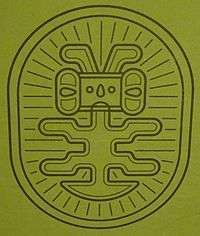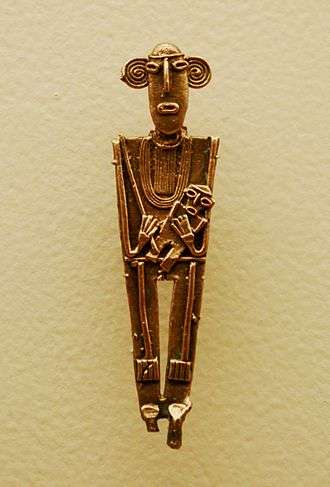Tunjo





A tunjo (from Muysccubun: tunxo)[1] is a small anthropomorh or zoomorph figure elaborated by the Muisca as part of their art. Tunjos were made of gold or tumbaga; a gold-silver-copper alloy. The Muisca used their tunjos in various instances in their religion and the small votive offering figures have been found in various places on the Altiplano Cundiboyacense, Colombia. Tunjos were used as offer pieces, to communicate with the gods and when the Muisca asked for favours from their deities.[2] Muisca scholar Pedro Simón wrote about the tunjos of the Muisca.[2]
Background
The Muisca, organised in their loose Muisca Confederation, exhibited one of the four advanced civilizations of the pre-Columbian Americas.[3] While the Aztec, the Maya and the Inca were famous for their grand architecture with temples, pyramids and cities, the Muisca lived in simple wooden and reed bohíos. The main skill of the Muisca was their goldworking. The Muisca made pectoral pieces, nose rings (narigueras), earrings, plates, poporos and other figures from the gold they traded with the surrounding indigenous groups, such as the Muzo, Panche, Guane, Pijao and others. One of the most common finds of these gold or tumbaga figures are the tunjos.[4]
Description
Tunjos were small figures picturing people, the deities of the Muisca religion or animals. They were used for three purposes; as ornaments in the graves of the Muisca people, from various social classes, as decoration at the entrances of temples and shrines, which once filled were buried in secret places by the Muisca priests and as offer ritual figures in the sacred lakes and rivers of the Muisca.[5]
Tunjos have been uncovered in Lake Guatavita, Bosa River; the river west of the Bogotá neighbourhood Bosa and in various other sacred sites of the Muisca. Tunjos have been found in caves too.[6] In 2001, a farmer found three tunjos in Carmen de Carupa, Cundinamarca.[2] Exactly the same figures have been found up to the Valle del Cauca in the south of Colombia.[5] The Pijao also made tunjos.[7]
Fabrication
The Muisca used to make matrixes or moulds of rock types such as shales and obsidian and poured their molten gold or tumbaga into the matrix. When the metals were cooled and solidified, they removed the stone moulds and the tunjos remained.[5] To create the 2D tunjos, they used bee wax to make the figure, put the wax tunjo in clay, that was heated to evaporate the wax and the gold or tumbaga was poured into the empty space left.[8]
Alloys
Various tunjos have been analysed with X-ray fluorescence (XRF) giving the following results:[5][9]
| metal | 1 | 2 | 3 | 4 | 5 | 6 | 7 | 8 | #2 | #8 |
|---|---|---|---|---|---|---|---|---|---|---|
| gold | 71.54 | 79.48 | 96.90 | 88.64 | 88.72 | 81.10 | 86.72 | 85.62 | 54.63 | 45.91 |
| silver | 23.67 | 18.01 | 2.48 | 11.05 | 10.02 | 12.18 | 12.79 | 12.79 | 16.31 | 10.55 |
| copper | 4.62 | 2.48 | traces | 0.12 | 1.11 | 5.94 | 1.16 | 1.47 | 29.31 | 43.70 |
| lead | traces | 0.28 | traces | |||||||
| iron | 0.02 | |||||||||
Museum collections
Of the relatively few Muisca artefacts that can be found in museums outside of Colombia, the tunjos are most common. Tunjos are in the collections of the American Museum of Natural History,[10] Art Institute Chicago,[11] Baltimore Museum of Art,[12] British Museum,[13] Brooklyn Museum,[14] Cleveland Museum of Art,[15] Dallas Museum of Art,[16] Hunt Museum (listed as "possible Peruvian" [sic]),[17] Metropolitan Museum of Art,[18] Museum of Fine Arts, Houston,[19] Princeton University Art Museum,[20] Smithsonian National Museum of the American Indian.[21]
Gallery
-

Tunjo in the Museo del Oro, Bogotá
-

Tunjo in the Museo del Oro
-

Tunjo in the Museo del Oro
Trivia
- the largest Colombian beer brand Club Colombia uses a tunjo in their symbolism
See also
 Muisca art
Muisca art Muisca economy
Muisca economy Gold Museum, Bogotá, the largest collection of tunjos and other indigenous Colombian golden art
Gold Museum, Bogotá, the largest collection of tunjos and other indigenous Colombian golden art Muisca religion
Muisca religion Los Tunjos Lake, a lake in the Sumapaz Paramo, named after the tunjos
Los Tunjos Lake, a lake in the Sumapaz Paramo, named after the tunjos
References
- ↑ (Spanish) Tunjo - Muysccubun Dictionary
- 1 2 3 (Spanish) Tunjos on Arte en la red
- ↑ Ocampo López, 2007, Ch.V, p.188
- ↑ (Spanish) Tunjos and other Muisca art - Pueblos Originarios
- 1 2 3 4 (Spanish) Description and metallurgy of tunjos - Museo del Oro - Bogotá
- ↑ (Spanish) Tunjos found in caves and other places
- ↑ (Spanish) Tunjo of the Pijao people
- ↑ Cooper, 2013
- ↑ Poster at the Museo del Oro, Bogotá
- ↑ Tunjo in American Museum of Natural History
- ↑ Tunjos in the Art Institute Chicago
- ↑ Tunjos in the Baltimore Museum of Art
- ↑ Tunjo in the British Museum
- ↑ Tunjo in the Brooklyn Museum
- ↑ Tunjos in the Cleveland Art Museum
- ↑ Tunjos in the Dallas Museum of Art
- ↑ Tunjo in Hunt Museum
- ↑ Tunjos in the Metropolitan Museum of Art
- ↑ Tunjos in the Museum of Fine Arts, Houston
- ↑ Tunjo in the Princeton University Art Museum
- ↑ Tunjo in the Smithsonian National Museum of the American Indian
Bibliography
- Cooper, Jago. 2013. The Lost Kingdoms of South America - Episode 3 - Lands of Gold. Accessed 2016-07-14.
- Ocampo López, Javier. 2007. Grandes culturas indígenas de América - Great indigenous cultures of the Americas, 1–238. Plaza & Janes Editores Colombia S.A..